Not too long ago, I told you about my journey to California to test ride three updated BMW motorcycles. The first day’s agenda was to ride BMW’s R 1250 GS and R1250 GS Adventure (GSA). On the second day, I would ride the BMW R 1250 RT (RT) sport-touring machine.
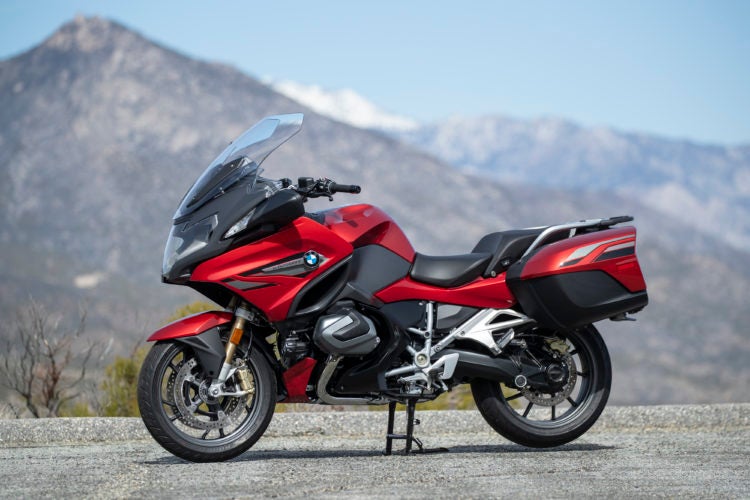
The BMW R 1250 RT. Photo credit: Kevin Wing
But because of a weather delay, I missed the R 1250 GS and R 1250 GS Adventure journo ride. Luckily, BMW was kind enough to loan me a GS Adventure for a week, and you may have already read that review/ride report. If you haven’t, you may want to because believe it or not, the GSA and the RT have several things in common.
But I did make it to the second-day journo event and got to ride BMW’s R 1250 RT for a day through the Anza-Borrego Desert and surrounding mountains. The scenery and route were superb. By the towards the middle of the day, the weather, not so much. More on that later.
I’ll be right upfront and let you know that touring bikes are not my first choice. But I certainly appreciate a machine that enables you to travel in comfort and allows you to enjoy the environment that surrounds you. Soaking it all in is a big deal in my book.
So let’s talk about the bike. (If you just want to know what it’s like to ride, skip down to the “Riding the RT” section below.) But I think you will want to know everything about this bike.
Weight
BMW says the RT is its lightweight dynamic sport-tourer. By comparison, at 609 pounds wet, the RT is significantly lighter than BMW’s K1600 tourer, which weighs in at about 765 pounds. That’s a very significant difference of more than 150 pounds.
When compared to the other similar touring-oriented bikes, it’s also among the lighter. Comparing liter plus size competitors like the Yamaha FJR and Honda’s “lightest” Goldwing model results in the RT being a claimed is 33 pounds and 178 pounds lighter, respectively. There are other lighter sportier touring models out there, but the RT is pointed more towards the touring than the sports spectrum.
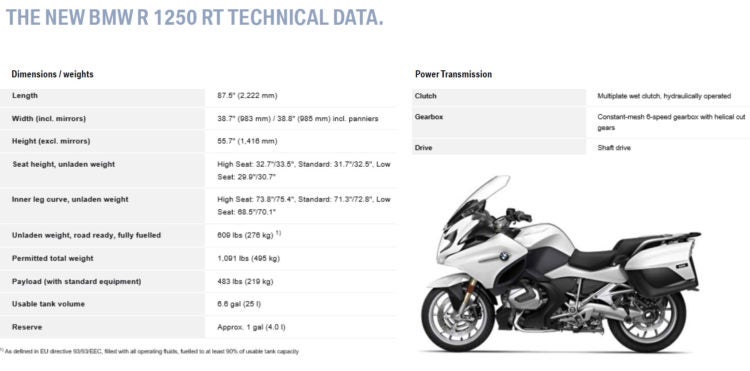
The RT’s top-level specs. Image credit: BMW
Walk around
Around 7:30 AM, I made my way to the parking lot where the RTs were ready. I found my ride for the day and did a quick once over. It struck me as having an art deco look. The bike had flowing lines with a modern touch. The optional Mars Red Metallic paint is not my thing but was well executed. After a quick walk around, it was time to get on the bike. Once aboard, I ran through a few things.
Keyless ignition
First, the bike is equipped with a “keyless” ignition. With your key in your pocket, starting the bike requires you to push a rubber inserted button at the top of the yoke to turn the ignition on. Once that has been accomplished, you can then fire up the bike with the traditionally located start button. That’s two steps when other keyless ignitions only require you to walk up the bike and push the start button. Not a big deal, but it is different.
Instrument panel
The instrument panel houses a traditional analog speedometer and tach. Other information is presented in a smaller separate electronic digital display panel between the analog instruments. The view of the digital display was sometimes hampered by reflections on its face, but it was not a huge issue.
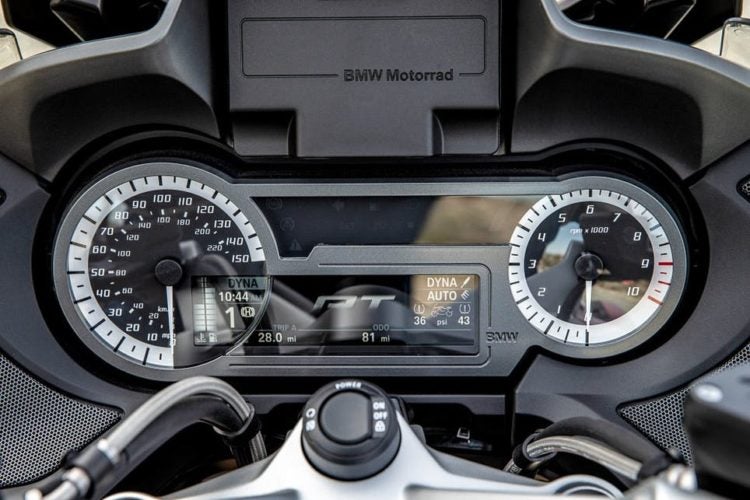
The RT’s instrument panel is a combination of analog and digital displays. That button at the top of the yoke is the ignition button. Photo credit: Kevin Wing
Ergonomics
Sitting on the bike, I moved the handlebars from left to right. The feel was very heavy. It was so heavy that I wondered whether the front tire was underinflated. Although the display said everything was up to snuff, I’d have to check it out once underway.
Seated, I could put both feet on the ground using the balls of my feet. My 30″ inseam was more than sufficient. The seat was very comfortable, as was the reach to the bars and seating position.
But when I put both feet on the pegs, my knees felt pretty high, cramped even. It could have been that I am used to a relatively long reach to my own bike’s pegs, but this is something taller riders will likely want to check. I should note that BMW offers both high and low seats so that adjusting the reach to the pegs should not be an issue.
Getting underway
By this time, it was nearing 8:00 AM, and we mounted up. The engine started quickly and smoothly; no warm-up is required. Just twist the throttle and go. The engine sound is quite similar to the GS since its the same one. It’s somewhat more muted, but you can still hear the engine internals moving and getting ready for work.
ShiftCam engine
The engine making the sounds beneath you is BMW’s new 1,254 cc ShiftCam Boxer Twin. It makes a claimed 136 horsepower at 7,750 RPM and 105 lb-ft of torque at 6,250 RPM. If you want more impressions of the engine, head on over to the R 1250 GSA review.

The increased performance of the BMW 1250 RT ShiftCam engine. Image credit: BMW
In a nutshell, the new ShiftCam engine introduces variable valve timing by “shifting” (i.e., moving) the intake cam from one cam profile to another. This provides the engine with the ability to use two separate cam profiles depending on engine load.
The “partial load” cam profile is used below 5,000 RPM and uses the lower lift cam profile. It offers a better fuel economy than its “full load” counterpart. But over 5,000 RPM, the cam “shifts,” and the “full load” higher profile cam profile is used. This cam enables maximum engine performance and gives the R 1250 RT that extra grunt when desired.

A brief overview of the inner workings of the ShiftCam engine. Image credit: BMW
The transition from one cam to the other is seamless. You will not notice the change occurring, but you will feel the extra power the “full load” cam provides.
Sometimes pictures (in this case video) are better than many words. This is a good visualization of the inner workings of the ShiftCam engine.
Even with the added complexity, BMW has been able to retain the same valve clearance checks as the previous engine. You’ll need to check them every 12,000 miles.
Electronics
Electronics are quickly becoming a mainstay of many motorcycles. Some people love them, and some dislike them. But on a bike with the mission that the RT has, electronics can be helpful and make riding more pleasurable.
The RT is equipped with an electronics package very similar to the GS/GSA. The electronics are accessed by moving a toggle switch and twisting a ring at the inside of the left handgrip. The system “toggles” were easy to use and readily available to your fingertips.
However, the menu for accessing certain settings was more of a hassle than it should be. Similar to the GS, the menu items are not very intuitive, and multiple steps are required to access those menus. It can be somewhat distracting and not something you want to deal with on the fly and even when stopped.
Once you get used to the menu and making changes, I’m sure it will be easier, but I think BMW needs to work on this. To make sure it wasn’t just me, I spoke with other testers who had similar opinions as well.
Suspension
The RT was designed and built to be a pavement touring machine. Its suspension reflects this bias. Up front is a BMW Telever unit with a 37 mm central spring strut. It provides 4.7 inches of travel. At the rear is a BMW single-sided swingarm featuring a WAD strut with 5.4 inches of travel. All of these specifications are more than up to the task of soaking up and maneuvering over paved surfaces for long distances in comfort.
We’ll talk about the suspension’s adjustability shortly.
“Optional” Select Package
But let’s get back to the electronic packages themselves and what they do. Most RTs delivered in North America will come with BMW’s optional $5,150 Select Package, so it’s probably a good idea if you know a little about them.
Included in this package (this is not a complete list) are items such as Next Generation Dynamic ESA (D-ESA), Gear ShiftAssist Pro, Ride Modes Pro with Dynamic Mode, Hill Start Control Pro (HSC), Dynamic Traction Control (DTC) and Dynamic Brake Control (DBC).
That’s quite a bit of technology, so let’s cover them briefly.

A breakout of the items included in the Select Package as well as other optional items. Image credit: BMW
Next Generation Dynamic ESA (D-ESA)
Next Generation Dynamic ESA (D-ESA) is a suspension system. If you don’t want to fiddle with suspension settings, the bike will adjust them for you automatically.
Preload settings can be adjusted automatically, or you can choose to set them yourself. Automatic is just that, automatic. The system will sense the weight it is carrying and adjust the preload accordingly. But if you want to be involved, you can adjust to one of two preload settings; “Minimum” or “Maximum.”
To adjust damping, you can toggle between Road and Dynamic settings. Using the Road setting adjusts the suspension for the most comfortable ride. The Dynamic mode stiffens things up a bit for a more sporty feel and ride.
Most of the time, I just left the suspension in the Dynamic mode. The Road mode was slightly softer, but I prefer a more “taut” ride, and the additional firmness helps the RT with stability when things get a little frisky.
Gear ShiftAssist Pro
Gear ShiftAssist Pro is a quick shifter. I’m not sure why BMW thinks it’s necessary on a bike like the RT. The RT is a tourer after all, and its forte’ is covering many miles in comfort swiftly. In my opinion, it’s not a bike to be banging up and downshifts in competition mode. I didn’t use it much frankly, but it does work.
Ride Modes Pro
Equipped as standard, the RT features two ride modes; Rain and Road. Rain mode offers a softened throttle response, and Road provides full engine capability.
But as said earlier, most bikes coming to North America will come equipped with the optional “Select Package” which includes Ride Modes Pro. Ride Modes Pro adds a Dynamic setting. This setting gives experienced riders more freedom and less automatic intervention in the operation of the bike.
BMW provided us with this chart. It’s a bit confusing, but it gives you an outline of what comes in both the standard and in the optional Ride Modes Pro packages.

A summary of the standard electronics and Ride Modes Pro. Image credit: BMW
Hill Start Control & Hill Start Control Pro (HSC)
The Hill Start Control function allows a rider to stop on a hill (either incline or decline) and have the bike hold itself in place until the rider is ready to ride away. HSC is now standard on the RT, but there are two different versions of the system.
The standard HSC system is activated by the rider firmly pulling the front or rear brake. With HSC Pro, the system automatically applies HSC depending on the angle it senses.
Dynamic Traction Control & ABS Pro
Both DTC and ABS Pro are rider aids. Both systems use a lean-angle sensor to assist the rider depending on the available traction. As traction decreases, the systems assist the rider by changing the throttle response or braking force.
Dynamic Brake Control (DBC)
Dynamic Brake Control (DBC) is one of BMW’s newest functions. In “panic” stop situations, DBC will automatically completely roll off the throttle in the event the rider doesn’t. It’s a feature I’ve never thought about for a motorcycle. But after thinking about it, it seems like a good idea.
Most of us have probably already been there. We jam on the brakes, start to fall off and try to hold onto the bike, potentially keeping the throttle open. This system closes the throttle for you. It’s a system you’ll likely not use. But if you need it, you’ll probably love it.
Pricing
The RT has a base price of $18, 645. However, most motorcycles imported to North America will come equipped with BMW’s Select Package, which adds another $5,150 to the base price. So you are looking at $23, 795 for the average Alpine white machine.
There are color options that come at an additional cost. The Mars Red Metallic bike in this review comes equipped with BMW’s sport package, and this will add $650 more, bringing the price to $25,445. If you want the Carbon Metallic Black machine, it comes with the elegance package and adds $450. This bike will cost you $24,245. For more details, see the chart below:
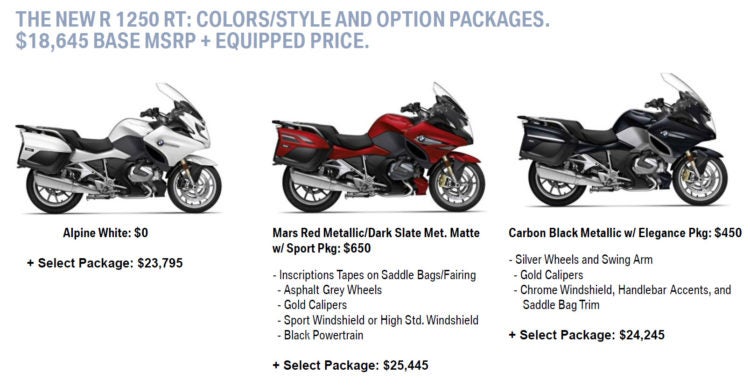
Riding the RT
Enough of the background stuff, let’s get to what it’s like to ride. As I noted earlier, at a stop, the steering felt quite heavy. But as we rolled away, the steering input required became less. It still did not feel super “flickable,” but the steering did lighten up substantially.

The RT negotiates corners well, but steering input is heavy. Photo credit: Kevin Wing
The day began in the sunshine, but the weather report said there was a chance of rain. With the mountains we were going to be traveling through, rain was a distinct possibility.
Before we could get into the mountain twisties and Anza-Borrego desert, we had several miles of stop and go traffic to deal with. Group riding requires you to stay in and keep up with the group. Three lanes of moderate city traffic with lots of stoplights make this “interesting” sometimes.
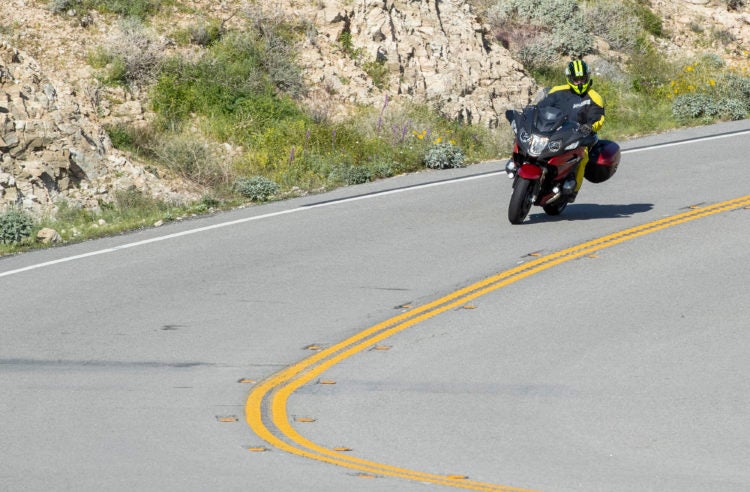
There were lots of twisties to play on. Photo credit: Kevin Wing
But frankly, this was a good test of the RT’s low-speed handling. Steering input was still a little heavy, but the bike could easily dart in and out of gaps in traffic. The RT was up to the challenge, and the ShiftCam engine made it easy to squirt in and out of lanes.
Since we only had an idea of the route we were to be following, there were times in the city when you had to be fairly hard on the gas to stay with the group. With speed up a bit, a traffic signal would turn red, and you had to get on the brakes. Sometimes fairly hard.
Brakes
But the BMW branded, Hayes manufactured four-piston calipers grabbing twin 320 mm front rotors were easily up to the task. They’re not racing quality stoppers, but they certainly are much better than the type of riding the RT is designed to handle. Out back, a Brembo dual-piston caliper on a 276 mm rotor adds to the RT’s stopping capabilities.
Into the mountains
After about a half-hour ride, we started climbing into the mountains on California 74. It’s an excellent twisty route with good pavement. Soon I was pushing the bike through the twisties.
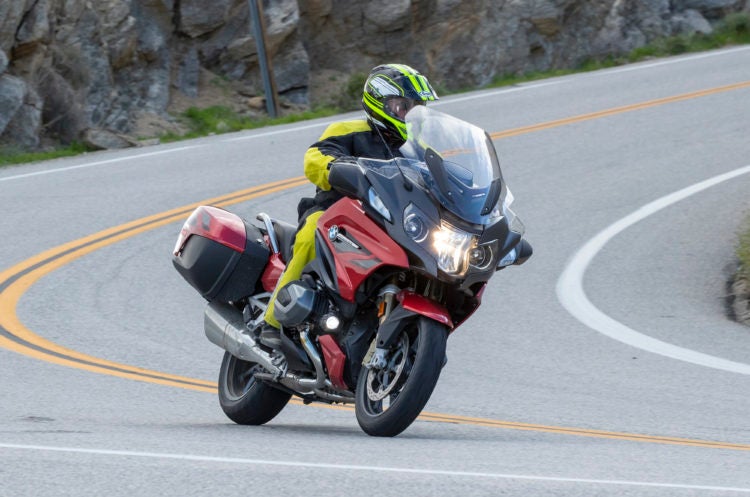
It’s starting to get darker. Rain is coming. Photo credit: Kevin Wing
The bike was capable in the turns but felt somewhat top-heavy. As you leaned into a corner, significant steering input was necessary. As the bike passed a certain lean point, it abruptly fell into the turn. In other words, it flopped into the corner.
But once established into the lean, the bike held its line well with no drama. Picking the bike back up from the corner once again required a little extra steering input. If I were to give the RT’s handling in corners a grade, it would be a solid B. Better than many but not outstanding.
Finicky panniers
After about two hours, we stopped at the Sugarloaf Cafe for some coffee. Since we would be off the bike for a while, I wanted to store my helmet in the bike’s panniers. The RT has panniers that can be locked and unlocked through the use of a button on the right handlebar.
However, when I went to unlock the panniers, as hard as I tried, I was unable to get either one to open. I sought the help of one of the ride leaders, and he was unable to unlock them either. None of the other journos had a similar problem, so the problem must have been with just my bike.
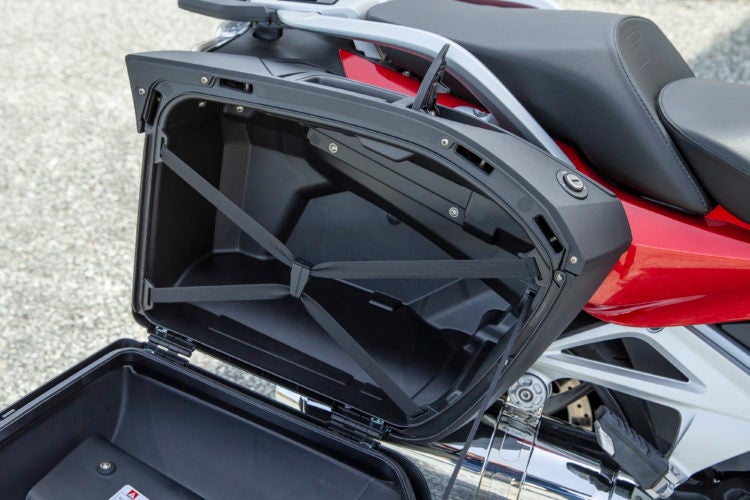
An open RT pannier. It’s capable of holding a full-face helmet. Photo credit: Kevin Wing
The rain comes
Soon after we finished our break, we descended from the mountains, and the road became less twisty. It also became much cloudier and colder. Then the rain came. At times it was quite heavy, but most of the time, it either light or medium in intensity. But as the temperature continued to drop, riding became less pleasant.
Even though we were riding in the rain, the pace was still spirited. Triple-digit speeds were not uncommon, and the bike was rock steady in the straights through puddles and little streams across the road. In the turns, the bike handled as previously explained.

It’s getting darker, and the rain is about to come. Photo credit: Kevin Wing
Staying dry
The brisk pace increased the discomfort of the elements, but the RT made the ride more comfortable than the weather. As the rain increased in intensity, I was able to reach over to the left grip and electrically raise the windshield to the height of my choice. I chose its highest setting. I could still see clearly over the top, but I was now in a nice pocket of air without rain or any buffeting. You could ride all day and have your torso fairly dry. It was that good.
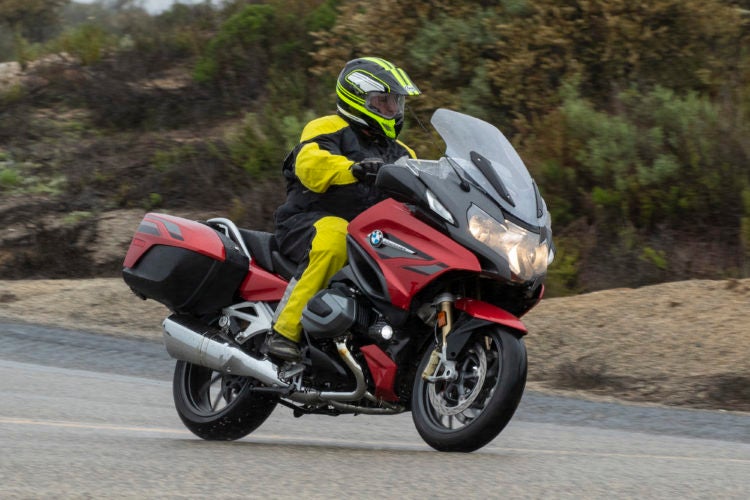
It has started to rain, and I have moved the windshield up. The result was a nice clean pocket of air with no buffeting. Photo credit: Kevin Wing
In addition, the RT comes equipped with both heated grips and a heated seat. Both work very, very well. Particularly the handgrips. They have a great deal of adjustability and provided just the right amount of heat to suit the outside temperature. The comfortable seat also kicked in some additional warmth.
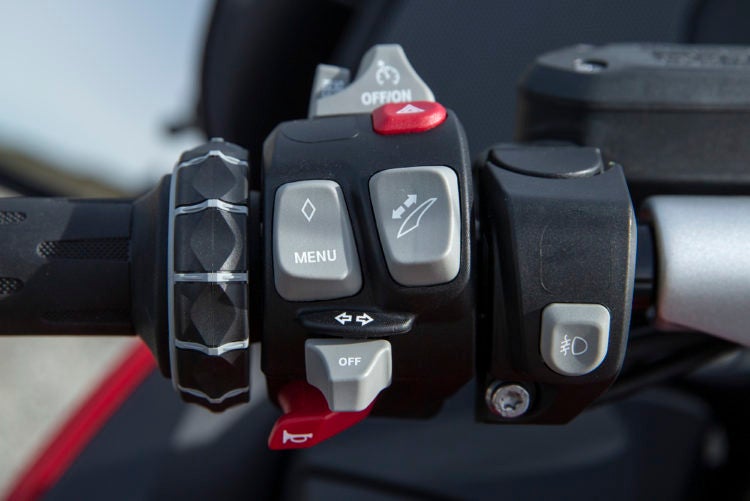
Adjusting the height of the windshield is as easy as pressing the big button with the windshield shaped diagram on the left-hand grip. Photo credit: Kevin Wing
An electrically operated windshield, heated grips, and seat may seem like luxury items, but when it’s cold and rainy, they are the bomb. They certainly help to make miserable riding conditions nicer and could help extend your trip in crap conditions versus riding without them.
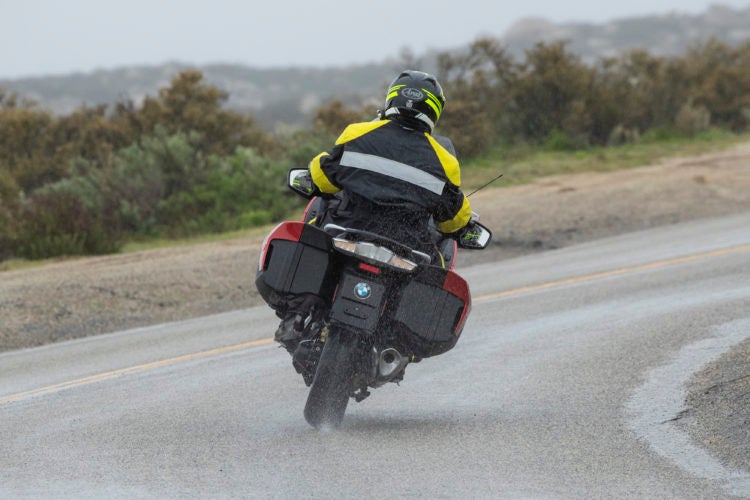
It’s now raining, and the RT still held its line nicely once established in the turn. Photo credit: Kevin Wing
The only fly in the grip heating ointment is turning them on. It takes quite a few menu toggles and selections to set them. Again, BMW should look into making the menu more intuitive.
Cruising
By the time we had finished a late lunch, the rain was coming to an end, and the temperatures were starting to increase. The roads we were now traveling were less twisty than their predecessors but gave us a chance to tour the surrounding landscapes. The cruising was enjoyable, and the comfort items like the adjustable windshield and heated grips/seat only made the ride more pleasant.
But as we neared the end of the day, we had a fairly long jaunt on Interstate 10 back to Palm Springs. Highway cruising is not the most interesting riding you can do, but it’s something that most people are subjected to every once in a while.
Once again, the riding became a bit spirited. The RT was highly capable of blazing a swift, easy path through the rush hour traffic at speed. It was easy to set the cruise control at well over the legal limit, and the RT just soaked it up. Set it and forget it. With no drama, you could set the cruise at 80 MPH and drone along all day in comfort.
Once back off the highway, we were still in rush hour traffic. Again the RT’s ShiftCam engine was able to squirt in and out of gaps with ease.
Final thoughts
When I first got off the RT at the end of the day, I still wasn’t sure about how I felt about it. It certainly has its strengths and weaknesses, and it was going to take a while for me to figure out an overall opinion.
It wasn’t until dinner that evening that I was able to draw a final conclusion. I was sitting next to several of the BMW folks, and one asked me what I thought about the bike. I told him what I did and didn’t like about the RT.
In a nutshell, I told him that the bike seemed a bit top-heavy and that the steering input was heavy. But then we got into riding in the rain and the highway ride, and that’s when it hit me.
The RT was designed to be a comfortable and powerful tourer. It is in this area where the RT shines. You can sit on the bike for a long time in all types of weather, and the ride would still be pleasant. Cruising backroads and highways are the bikes forte’. Its engines cruises smoothly, quietly, and the bike’s comfort systems make the ride all the better.
So that’s it. The RT is not a highly sporty bike. That’s not in its design. Instead, the RT is a good road going cruiser that provides a comfortable ride and can haul you, a significant other, and your belongings long distances. And it does it well.







